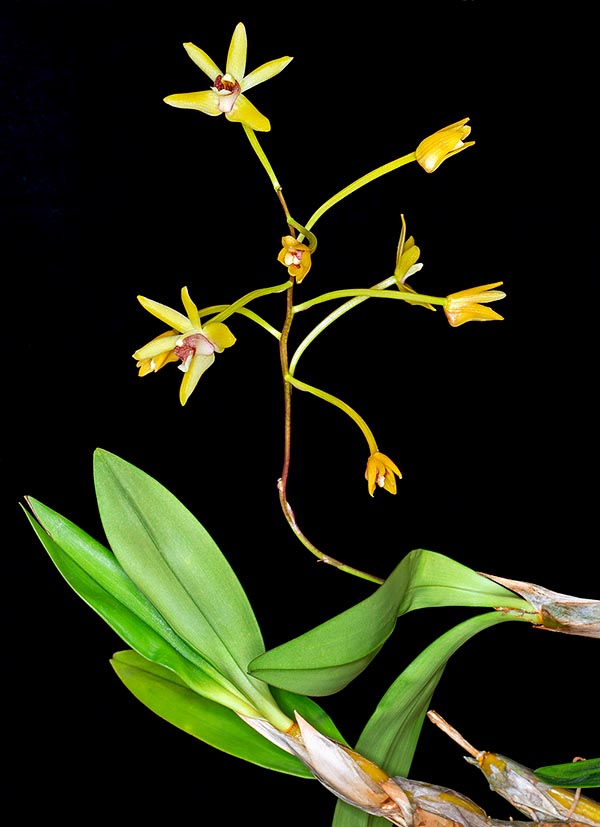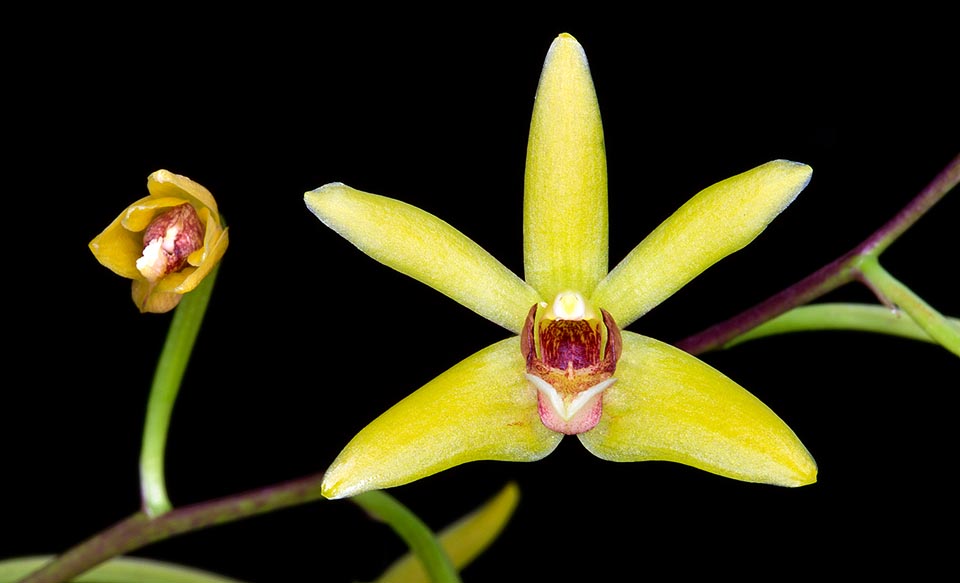Family : Orchidaceae

Text © Pietro Puccio

English translation by Mario Beltramini

Epiphyte or lithophyte with creeping woody rhizome of 4-5 mm of diameter, the Dendrobium geminatum is a little cultivated species present on a vast area in the South-East Asia forests © Giuseppe Mazza
The name of the genus is the combination of the Greek substantives “δένδρον” (dendron) = tree and “βίος” (bios) = life, with reference to the numerous species of the genus living on the trees; the specific name is the Latin adjective “geminatus, a, um” = double, with reference to the inflorescences that generate often coupled in the apical part of the pseudobulb.
The Dendrobium geminatum (Blume) Lindl. (1830) is an epiphytic or lithophytic species with creeping woody rhizome, of 4-5 mm of diameter, and close ovoidal pseudobulbs, grooved, slightly compressed laterally, 2-3,5 cm long and of 0,6-2 cm of diameter, with ramification in various directions with smaller pseudobulbs spaced of 5-15 cm.
The pseudobulbs are provided at the apex of two ovoidal-elliptical to lanceolate leaves with irregularly bilobed apex, 4-12 cm long and 1-2,2 cm broad, coriaceous.
Racemose inflorescences that develop in the same time as the pseudobulb in the apical zone, solitary or more frequently geminate (paired), 6-10 cm long, bearing 3-9 flowers, on a pedicel and ovary about 2 cm long, of 2,5-3 cm of diameter, of cream to pale yellow colour with the lateral lobes of the labellum having brown-purple spottings and median lobe with white margin, long lasting. Lanceolate dorsal sepal with sub-acute apex, 1,3-1,8 cm long and 0,4-0,5 cm broad, lanceolate lateral sepals with sub-acute apex, 1,3-1,5 cm long and 0,7 cm broad, united at the base of the column to form a spur (mentum) about 0,4 cm long.
Linear petals, 1,2-1,6 cm long and 0,2-0,25 cm broad, trilobed labellum, 1-1,2 cm long and 0,6-0,7 cm broad (spread), with erect lateral lobes with rounded margin at the sides of the column and triangular median lobe with acuminate apex; the column is about 0,4 cm long.
It reproduces at amateur level by division, with each section provided of at least 3-4 pseudobulbs.
Species distributed on a vast area of South-East Asia, but little present in cultivation, requires slight shade, intermediate temperatures, with lowest ones not under the 16 °C, high humidity, 75-85 %, and constant ventilation.

Close 2-3,5 cm pseudobulbs with 4-12 cm leaves and racemose inflorescences bearing 3-9 flowers of 2,5-3 cm of diameter © Giuseppe Mazza
The species is reported in the appendix II of the CITES (species whose trade is internationally ruled).
Synonyms: Desmotrichum geminatum Blume (1825); Callista geminata (Blume) Kuntze (1891); Sarcopodium geminatum (Blume) Rolfe (1910); Katherinea geminata (Blume) A.D.Hawkes (1956); Epigeneium geminatum (Blume) Summerh. (1957).
→ For general notions about ORCHIDACEAE please click here.
